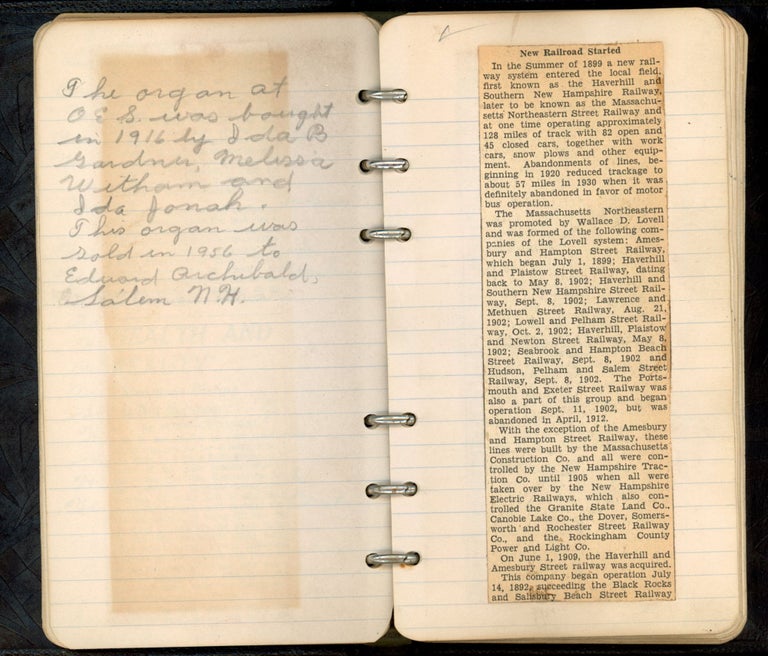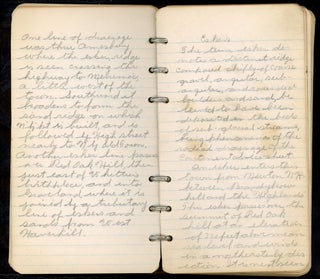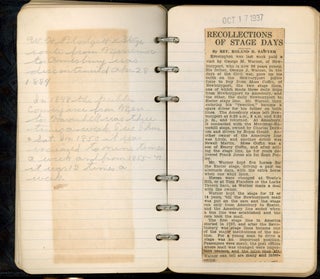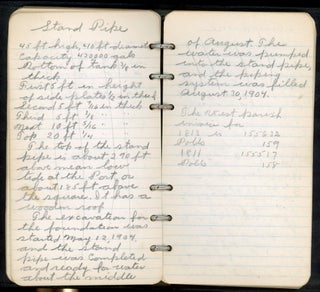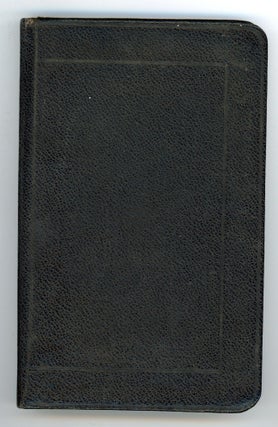MERRIMAC, ESSEX COUNTY, MA c. 1940 HANDWRITTEN NOTEBOOK SCRAPBOOK
Item #686
Black 6-ring notebook measuring 4.5 x 7”, filled with handwritten notes about Essex County, Massachusetts, with a specific focus on Merrimac. The notebook starts with a newspaper clipping which describes Essex County as one of the oldest counties in Massachusetts with a list of the original towns. There are other newspaper clippings throughout the notebook, but it is mostly handwritten notes detailing various aspects of the history of Essex County. These notes discuss eskers, schools, the public library, shops, ice businesses, railroads, and politics. The note-taker often discusses specific individuals that were important to local history. The notebook appears to be from sometime in the late 1940s or early 1950s based on the dates of the newspaper clippings.
Example note entries
Public Library
The development of free public libraries as they now exist was made possible by a series of acts passed by the State Legislature. In 1890 the Legislature authorized the Governor to appoint five persons to constitute a board of trustees, who among functions, were to advise local libraries and to provide $100 for the purchase of books for any town not possessing a public library. By 1904 the only town in the State which did not have a public library was Newbury, but in 1926 this town founded its own library thus giving Massachusetts the national record of being the first State to have a free public library in every organized city and town.
The history of the various public libraries is very similar. Generally there was an initial gift by one or more public spirited citizens: occasionally the books of an old “Social” or “Philosophical” library were the foundation of the new collection.
These Social Libraries were formed by groups of citizens in the different towns for the purpose of the purchase and use of books. They [illegible] shares, fixed annual dues, called themselves “proprietors,” and named their organization a “Social Library.” A variant of the Social Library was the Philosophical Library which appeared at about the same time and was practically the same except for difference in the choice of books…
That Merrimac possesses an excellent library is due to the generosity of Dr. James R. Nichols of Haverhill, a native of this town, who offered to present one thousand volumes of select works as a nucleus for a public library. The citizens unanimously voted Aug. 21, 1876, to accept the offer and on Wednesday evening May 10, 1877 the library was formally opened and dedicated to the use of the town.
The occasion was one of much interest, and Sargent Hall was filled with people. Rev. Wm. H. Hubbard presided, delivering an appropriate address. Dr. Nichols, the donor of the library, spoke at some length upon the proper books for instruction and reference. The meeting was also addressed by Mayor J. K. Jenness and Rev. Dr. Seeley, both of Haverhill.
Mr. George E. Ricker was elected the first librarian and served until 1883, when Mr. Edmund W. Ricker served for one year and Mr. George Ricker was again elected librarian.
Schools
Astringent law was passed in 1702, making it obligatory upon towns to maintain schools and employ qualified teachers other than ministers, under penalty of £20. Hitherto it had been customary to employ the minister to teach the children, thus adding a trifle to his scanty salary. To comply with the law, the town established a free school and authorized the selectman to hire a master.
The first schoolhouse in this part of the town was probably in the fort of [illegible], as Merrill’s History of Amesbury say in 1711 “At a general meeting it was voted that” ye school should be kept ye first four months at ye town Meeting house ye next four months at ye Pond Hills fort and ye last four months at Left Foots fort or there abouts.”
Schools were yet anything but permanent institutions being mostly kept in private houses, but in 1720 it was voted “that ye school shall be kept at Jamaco five months from ye first of February last and the school shall be moved to town and there kept till seven months is expired after his removal from town.”
In 1802 Moses Sawyer kept school 13 weeks at the River and 11 weeks at the Highlands.
Merrill History
1834-1837-1839-1868-1869-
World War
Little did the people of Merrimac think, when they read in the newspapers of the start in Europe of what resulted in the World War, that within the short space of two years, their sons would be marching away to take part in the war that resulted, and that they would be called upon to support in every way possible the efforts of the county in which they lived to “make the world safe for democracy.”
There followed the declaration of war, a period of volunteering, and then the draft and before the armistice was announced on Nov. 11, 1918, there were 88 Merrimac boys enrolled under the Stars and Stripes, and doing their full duty in practically every kind of an organization which went to make up the army and navy raised by this country.
Not only in the army and navy, but at home the people of Merrimac did their full duty and in supporting Liberty Loans, Red Cross, and all the other numerous drives always did their full duty. Heatless, wheatless, meatless, sugarless, gasolineless, and all other days of this sort, so frequent during the war, were strictly observed, and Merrimac and her citizens can feel that they were staunch supporters of the government during the trying days of the World war.
Price: $150.00

